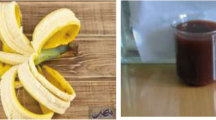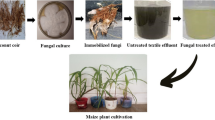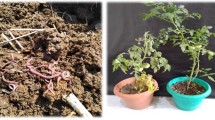Abstract
Farming, food processing, animal husbandry and other agro-based activities contribute to global environmental degradation by producing millions of tons of organic and inorganic solid waste. In terms of sustainable agriculture, agricultural waste management and conversion into useful products are essential. In addition, plants are facing various kinds of biotic stress, which ultimately affects their defense system. Altered defense systems in plants ultimately lead to the death of plants and a reduction in crop production. The present study is designed to keep the abovementioned fact in mind, which mainly focuses on the reuse of agricultural waste and its application to the antioxidant potential and structural components of tomato plants during nematode stress. In the present study, neem leaves were collected and mixed with cattle dung for the preparation of vermicompost. Then, tomato seeds were pre-treated with vermicompost extract before being germinated in earthen pots. After germination, they were transplanted to separate pots and inoculated with freshly hatched juveniles of Meloidogyne incognita. The experiments were conducted for 10 days under glass house conditions, and after that, plants were harvested and various physiological (antioxidant capacity, percent electrolyte leakage) and structural markers (carbohydrate content, Fourier transform infrared spectroscopy) were analyzed. Results revealed that all physico-chemical properties make vermicompost superior as compared to soil and pre-compost material. Further, nematode stress leads to altered physiological and structural markers as compared to uninfected seedlings. However, treatment with vermicompost significantly increases carbohydrate content and antioxidative capacity in a concentration dependent manner. In addition, electrolyte leakage was found to be decrease with an increase in the concentration of vermicompost. All these findings conclude that vermicompost has strong potential to limit the damage caused by nematodes and boost the antioxidant potential of the host plants. Further, this study provides strong evidence for using vermicompost as an eco-friendly alternative to chemical nematicides and a potential strategy for agricultural waste management. This is the first study in which the tomato plant’s structural and physiological markers were assessed during nematode stress after being supplemented with vermicompost under glass house conditions for an initial 10 days of nematode exposure.




Similar content being viewed by others
Data availability
Data will be made available on request.
References
Almeida MM, de Sousa PH, Arriaga ÂM, do Prado GM, de Carvalho Magalhães CE, Maia GA, de Lemos TL (2011) Bioactive compounds and antioxidant activity of fresh exotic fruits from northeastern Brazil. Food Res Int 44:2155–2159. https://doi.org/10.1016/j.foodres.2011.03.051
Amal TC, Karthika P, Balamurugan V, Shanmugam G, Selvakumar S, Sundararaj P, Vasanth K (2020) Effects of root-knot nematode inoculums densities on morphological and phytochemical analysis of selected horse gram germplasm. Indian J Agric Res 54(6):708–715. https://doi.org/10.18805/IJARe.A-5430
Arts MJ, Haenen GR, Voss HP, Bast A (2004) Antioxidant capacity of reaction products limits the applicability of the trolox equivalent antioxidant capacity (TEAC) assay. Food Chem Toxicol 42:45–49
Bali S, Kaur P, Jamwal VL, Gandhi SG, Sharma A, Ohri P, Bhardwaj R, Ali MA, Ahmad P (2020) Seed priming with jasmonic acid counteracts root-knot-nematode infection in tomato by modulating the activity and expression of antioxidative enzymes. Biomolecules 10(1):98. https://doi.org/10.3390/biom10010098
Balwan WK, Saba N, Singh N, Rasool N (2020) Solid waste management: first report on garbage problem in Doda Region of Jammu and Kashmir. India. Population 11(17):41
Bhatia L, Jha H, Sarkar T, Sarangi PK (2023) Food waste utilization for reducing carbon footprints towards sustainable and cleaner environment: a review. Int J Env Res Pub He 20(3):2318. https://doi.org/10.3390/ijerph20032318
Bremner JM, Mulvaney RG (1982) Nitrogen-total. In: Page AL, Miler RH, Keeney DR (eds) Methods of soil analysis Part 2. American Society of Agronomy, Madison, Wisconsin, USA, pp 595–624
Das SK, Patra JK, Thatoi H (2016) Antioxidative response to abiotic and biotic stresses in mangrove plants: a review. Int Rev Hydrobiol 101(1-2):3–19. https://doi.org/10.1002/iroh.201401744
Devi TS, Das D, Ansari RA, Rizvi R, Sumbul A, Mahmood I (2020) Role of organic additives in the sustainable management of phytoparasitic nematodes. In: Ansari R, Rizvi R, Mahmood I (eds) Management of Phytonematodes: Recent Advances and Future Challenges. Springer, Singapore, pp 279–295. https://doi.org/10.1007/978-981-15-4087-5_12
Dhiman S, Ibrahim M, Devi K, Sharma N, Kapoor N, Kaur R, Sharma N, Tikoria R, Ohri P, Mir BA, Bhardwaj R (2021) Biochar assisted remediation of toxic metals and metalloids. In: Handbook of Assisted and Amendment: Enhanced Sustainable Remediation Technology. John Wiley and Sons Ltd, USA, pp 131–162. https://doi.org/10.1002/9781119670391.ch7
Dhiman S, Singh AD, Kour J, Bhardwaj T, Devi K, Tikoria R, Ohri P, Bhardwaj R, Sharma P (2023) Redox homeostasis in response to abiotic stresses in plants. In: Singh A (ed) The role of growth regulators and phytohormones in overcoming environmental stress. Academic Press, London, pp 15–37. https://doi.org/10.1016/B978-0-323-98332-7.00014-7
dos Santos PT, Macêdo AG, da Silva J, Pinheiro JB, de Paula AM, Biscaia D, Busato JG (2020) Water-extractable fraction of vermicomposts enriched with Trichoderma enhances the growth of bell pepper and tomato as well as their tolerance against Meloidogyne incognita. Sci Hortic 272:109536. https://doi.org/10.1016/j.scienta.2020.109536
dos Santos PT, Monteiro de Paula A, Ferrari LH, da Silva J, Borges Pinheiro J, Navas Cajamarca SM, Jindo K, Pupo Santos M, Zandonadi DB, Busato JG (2021) Trichoderma-enriched vermicompost extracts reduces nematode biotic stress in tomato and bell pepper crops. Agronomy 11(8):1655. https://doi.org/10.3390/agronomy11081655
Dutta R, Angmo D, Singh J, Chowdhary AB, Quadar J, Singh S, Vig AP (2023) Synergistic Effect of Biochar amendment in Milk Processing Industry Sludge and Cattle dung during the Vermiremediation. Bioresour Technol 371:128612. https://doi.org/10.1016/j.biortech.2023.128612
Ebrahimi M, Souri MK, Mousavi A, Sahebani N (2021) Biochar and vermicompost improve growth and physiological traits of eggplant (Solanum melongena L.) under deficit irrigation. Chem Biol Technol Agric 8(1):1–14. https://doi.org/10.1186/s40538-021-00216-9
Fullana AM, Exposito A, Escudero N, Cunquero M, Loza-Alvarez P, Gine A, Sorribas FJ (2023) Crop rotation with Meloidogyne-resistant germplasm is useful to manage and revert the (a) virulent populations of Mi1. 2 gene and reduce yield losses. Front. Plant Sci 14:1133095. https://doi.org/10.3389/fpls.2023.1133095
Ganguly RK, Chakraborty SK (2020) Eco-management of industrial organic wastes through the modified innovative vermicomposting process: a sustainable approach in tropical countries. In: Bhat S, Vig AP, Li F, Ravindran B (eds) Earthworm Assisted Remediation of Effluents and Wastes. Springer, Singapore, pp 161–177. https://doi.org/10.1007/978-981-15-4522-1_10
Griffiths PR, De Haseth JA (2007) Fourier transform infrared spectrometry. John Wiley & Sons, Inc, USA. https://doi.org/10.1002/047010631X
Hedge JE, Hofreiter BT, Whistler RL (1962) In: Whistler RL, Be Miller JN (eds) Carbohydrate chemistry. Academic Press, New York, pp 371–380
Hernandez OL, Calderín A, Huelva R, Martínez-Balmori D, Guridi F, Aguiar NO, Olivares FL, Canellas LP (2015) Humic substances from vermicompost enhance urban lettuce production. Agron Sustain Dev 35:225–232. https://doi.org/10.1007/s13593-014-0221-x
Jagadeesh B, Maurya SK, Hemalatha P, Lingam A (2022) Diseases and disorders of cole crops (Stem Brassicas) and their management. In: Srivastava JN, Singh AK (eds) Diseases of horticultural crops Apple. Academic Press, New Jersey, pp 79–129
John MK (1970) Colorimetric determination of phosphorus in soil and plant materials with ascorbic acid. Soil Sci 109:214–220
Kaur P, Kocher GS, Taggar MS (2023) Comparative assessment of fungal consortium ligninolytic enzymes versus sequential acid–alkali pretreatments for bioethanol production from rice straw. Bioenergy Res 1-11. https://doi.org/10.1007/s12155-023-10612-8
Khanna K, Jamwal VL, Kohli SK, Gandhi SG, Ohri P, Bhardwaj R, Wijaya L, Alyemeni MN, Ahmad P (2019) Role of plant growth promoting Bacteria (PGPRs) as biocontrol agents of Meloidogyne incognita through improved plant defense of Lycopersicon esculentum. Plant Soil 436(1):325–345. https://doi.org/10.1007/s11104-019-03932-2
Kolodziejczyk-Czepas J, Bijak M, Saluk J, Ponczek MB, Zbikowska HM, Nowak P, Tsirigotis-Maniecka M, Pawlaczyk I (2015) Radical scavenging and antioxidant effects of Matricaria chamomilla polyphenolic–polysaccharide conjugates. Int J Biol Macromol 72:1152–1158. https://doi.org/10.1016/j.ijbiomac.2014.09.032
Koul B, Yakoob M, Shah MP (2022) Agricultural waste management strategies for environmental sustainability. Environ Res 206:112285. https://doi.org/10.1016/j.envres.2021.112285
Lu XH, Sun DQ, Wu QS, Liu SH, Sun GM (2014) Physico-chemical properties, antioxidant activity and mineral contents of pineapple genotypes grown in China. Molecules 19(6):8518–8532. https://doi.org/10.3390/molecules19068518
Mago M, Gupta R, Yadav A, Garg VK (2022) Sustainable treatment and nutrient recovery from leafy waste through vermicomposting. Bioresour Technol 347:126390. https://doi.org/10.1016/j.biortech.2021.126390
Mishra S, Wang KH, Sipes BS, Tian M (2018) Induction of host-plant resistance in cucumber by vermicompost tea against root-knot nematode. Nematropica 48(2):164–171
Mokrini F, Janati S, Houari A, Essarioui A, Bouharroud R, Mimouni A (2018) Management of plant parasitic nematodes by means of organic amendment. Rev Mar Sci Agron Vet 6:337–344
Nur FO, Siti AH, Umi KY (2013) Comparative evaluation of organic and inorganic fertilizers on total phenolic, total flavonoid, antioxidant activity and cyanogenic glycosides in cassava (Manihot esculenta). Afr J Biotechnol 12(18):2414–2421
Omran BA, Baek KH (2022) Valorization of agro-industrial biowaste to green nanomaterials for wastewater treatment: Approaching green chemistry and circular economy principles. J Environ Manage 311:114806. https://doi.org/10.1016/j.jenvman.2022.114806
Panda SK, Matsumoto H (2007) Molecular physiology of aluminum toxicity and tolerance in plants. Bot Rev 73(4):326–347
Parthasarathi K, Balamurugan M, Ranganathan LS (2008) Influence of vermicompost on the physico-chemical and biological properties in different types of soil along with yield and quality of the pulse crop-blackgram. J Environ Health Sci Eng 5(1):51–58
Nelson DW, Sommers LE (1996) Total carbon, organic carbon and organic matter. In: Sparks DL, Page AL, Helmke PA, Loeppert RH, Soltanpour PN, Tabatabai MA, Johnston CT, Sumner ME (eds) Methods of soil analysis: part 3 chemical methods. American Society of Agronomy, Madison, pp 961–1010
Pizzeghello D, Nicolini G, Nardi S (2001) Hormone-like activity of humic substances in Fagus sylvaticae forests. New Phytol. 151(3):647–657
Poveda J, Abril-Urias P, Escobar C (2020) Biological control of plant-parasitic nematodes by filamentous fungi inducers of resistance: Trichoderma, mycorrhizal and endophytic fungi. Front Microbiol 11:992. https://doi.org/10.3389/fmicb.2020.00992
Prasad M, Ranjan R, Ali A, Goyal D, Yadav A, Singh TB, Shrivastav P, Dantu PK (2020) Efficient transformation of agricultural waste in India. In: Ansari AA, Naeem M, Gill SS (eds) Contaminants in agriculture: sources, impacts and management. Springer nature Switzerland, pp 271–287. https://doi.org/10.1007/978-3-030-41552-5_13
Quadar J, Chowdhary AB, Dutta R, Angmo D, Rashid F, Singh S, Singh J, Vig AP (2022) Characterization of vermicompost of coconut husk mixed with cattle dung: physicochemical properties, SEM and FT-IR analysis. Environ Sci Pollut Res 29(58):87790–87801. https://doi.org/10.1007/s11356-022-21899-z
Ralmi NHAA, Khandaker MM, Mat N (2016) Occurrence and control of root-knot-nematode in crops: a review. Aust J Crop Sci 10(12):1649–1654
Rao MS, Kamalnath M, Umamaheswari R, Rajinikanth R, Prabu P, Priti K, Grace GN, Chaya MK, Gopalakrishnan C (2017) Bacillus subtilis IIHR BS-2 enriched vermicompost controls root-knot-nematode and soft rot disease complex in carrot. Sci. Hortic 218:56–62. https://doi.org/10.1016/j.scienta.2017.01.051
Rawat N, Singla-Pareek SL, Pareek A (2021) Membrane dynamics during individual and combined abiotic stresses in plants and tools to study the same. Physiol Plant 171(4):653–676. https://doi.org/10.1111/ppl.13217
Schiavon M, Lima LW, Jiang Y, Hawkesford MJ (2017) Effects of selenium on plant metabolism and implications for crops and consumers. In: Pilon-Smits E, Winkel L, Lin ZQ (eds) Selenium in plants: Molecular, physiological, ecological and evolutionary aspects. Springer, Cham, pp 2547–2275. https://doi.org/10.1007/978-3-319-56249-0_15257-275
Schiavon M, Pizzeghello D, Muscolo A, Vaccaro S, Francioso O, Nardi S (2010) High molecular size humic substances enhance phenylpropanoid metabolism in maize (Zea mays L.). J Chem Ecol 36:662–669. https://doi.org/10.1007/s10886-010-9790-6
Sijmons PC, Atkinson HJ, Wyss U (1994) Parasitic strategies of root nematodes and associated host cell responses. Annu Rev Phytopathol 32(1):235–259
Singh K, Bhartiya DK (2021) A review article on vermibiotechnology and waste management. World Rev Sci Technol Sustain Dev 17(1):81–97. https://doi.org/10.1504/WRSTSD.2021.113976
Singh SI, Singh WR, Bhat SA, Sohal B, Khanna N, Vig AP, Ameen F, Jones S (2022) Vermiremediation of allopathic pharmaceutical industry sludge amended with cattle dung employing Eisenia fetida. Environ Res 214:113766. https://doi.org/10.1016/j.envres.2022.113766
Sivakumar M, Gunasekaran K (2011) Management of root-knot-nematodes in tomato, chilli and brinjal by neem oil formulations. J Biopestic 4:198–200
Strilling GR (1991) Biological control of plant parasitic nematodes. CAB International, Wallingford, UK
Taylor DP, Netscher C (1974) An improved technique for preparing perineal patterns of Meloidogyne spp. Nematologica 20:268–269
Tikoria R, Kaur A, Ohri P (2022a) Modulation of various phytoconstituents in tomato seedling growth and Meloidogyne incognita–induced stress alleviation by vermicompost application. Front Environ Sci 10:891195. https://doi.org/10.3389/fenvs.2022.891195
Tikoria R, Kaur A, Ohri P (2022b) Potential of vermicompost extract in enhancing the biomass and bioactive components along with mitigation of Meloidogyne incognita-induced stress in tomato. Environ Sci Pollut Res 29:56023–56036. https://doi.org/10.1007/s11356-022-19757-z
Tikoria R, Kaur A, Ohri P (2023a) Amelioration of oxidative stress and growth enhancement by application of vermicompost via modulating phyto-constituents in tomato plants during nematode stress. J Soil Sci Plant Nutrit 1-17. https://doi.org/10.1007/s42729-023-01313-4
Tikoria R, Kaur A, Ohri P (2023b) Physiological, biochemical and structural changes in tomato plants by vermicompost application in different exposure periods under glass house conditions. Plant Physiol Biochem 197:107656. https://doi.org/10.1016/j.plaphy.2023.107656
Wang D, Shi Q, Wang X, Wei M, Hu J, Liu J, Yang F (2010) Influence of cow manure vermicompost on the growth, metabolite contents and antioxidant activities of chinese cabbage (Brassica campestris spp. chinensis). Biology Fertil Soils 46:689–696. https://doi.org/10.1007/s00374-010-0473-9
Xiao Z, Liu M, Jiang L, Chen X, Griffiths BS, Li H, Hu F (2016) Vermicompost increases defense against root-knot nematode (Meloidogyne incognita) in tomato plants. Appl Soil Ecol 105:177–186
Xie X, He Z, Chen N, Tang Z, Wang Q, Cai Y (2019) The roles of environmental factors in regulation of oxidative stress in plant. Bio Med Res Int 2019:9732325. https://doi.org/10.1155/2019/9732325
Yan Y, Mao Q, Wang Y, Zhao J, Fu Y, Yang Z, Peng X, Zhang M, Bai B, Liu A, Chen S (2021) Trichoderma harzianum induces resistance to root-knot nematodes by increasing secondary metabolite synthesis and defense-related enzyme activity in Solanum lycopersicum L. Biol Control 158:104609. https://doi.org/10.1016/j.biocontrol.2021.104609
Yen G-C, Chen H-Y (1995) Antioxidant activity of various tea extracts in relation to their antimutagenicity. J Agric Food Chem 43:27–32
Yusof Z, Ramasamy S, Mahmood NZ, Yaacob JS (2018) Vermicompost supplementation improves the stability of bioactive anthocyanin and phenolic compounds in Clinacanthus nutans lindau. Molecules 23(6):1345. https://doi.org/10.3390/molecules23061345
Funding
R.T. is financially supported by CSIR-New Delhi {File no. 09/254(0287)/2018-EMR-I}.
Author information
Authors and Affiliations
Contributions
Raman Tikoria: methodology, conceptualization, analysis, manuscript preparation, revision, proof reading; Puja Ohri: supervision and investigation, review and editing.
Corresponding author
Ethics declarations
Ethics approval
Ethical approval for this work is not required.
Consent to participate
Not applicable.
Consent for publication
All the authors agreed to publish this work in ESPR.
Conflict of interest
The authors declare no competing interests.
Additional information
Responsible Editor: Chris Lowe
Publisher’s Note
Springer Nature remains neutral with regard to jurisdictional claims in published maps and institutional affiliations.
Rights and permissions
Springer Nature or its licensor (e.g. a society or other partner) holds exclusive rights to this article under a publishing agreement with the author(s) or other rightsholder(s); author self-archiving of the accepted manuscript version of this article is solely governed by the terms of such publishing agreement and applicable law.
About this article
Cite this article
Tikoria, R., Ohri, P. Application of neem waste vermicompost in compensating nematode induced stress and upregulating physiological markers of tomato plants under glass house conditions after 10 days of exposure. Environ Sci Pollut Res (2023). https://doi.org/10.1007/s11356-023-30324-y
Received:
Accepted:
Published:
DOI: https://doi.org/10.1007/s11356-023-30324-y




